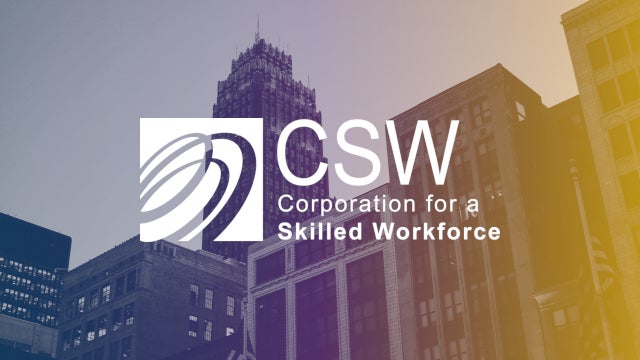This week marked the fourth annual National Apprenticeship Week. In recent years, apprenticeship programs have received increased attention, with leaders across sectors recognizing the benefits of combining paid work with classroom instruction. As policymakers grapple with the challenges surrounding the future of work, apprenticeships provide one model for better connecting workers with in-demand skills for the jobs of the future.
Benefits of apprenticeships include:
- Aligned curricula. Employers who offer apprenticeships help schools ensure that curricula are aligned relevant job skills;
- Training that pays. At a time when Americans are carrying a record $1.5 trillion in student loan debt, apprenticeships actually pay workers while they are in school;
- Effective instructional method. Work-based instruction is a particularly effective form of teaching, especially for those who have difficulty with traditional classroom learning;
- Post-graduation employment. Apprenticeships connect training to employment, helping ensure workers have a job waiting for them when they graduate;
- Higher lifetime earnings. A 2012 study found that registered apprentices earned roughly $240,000 more over their lifetimes than similar workers who had not gone through such programs.
Today, there are more than 533,000 apprentices in the United States. While this number has grown over the past few years, at 0.3 percent of the U.S. labor force, apprenticeships still represent a small fraction of the workforce when compared to other countries.
Efforts to increase the number of apprenticeships have broad bipartisan support with advocates at the federal, state, and local levels. At the federal level, both the Trump administration and Obama administration prioritized expanding apprenticeship programs as a way to align the needs of workers and employers. In Congress, the Apprenticeship and Jobs Training Act of 2017–which seeks to expand the use of apprenticeships through an employer tax credit–has bipartisan support in both the House of Representatives and Senate. The Leveraging and Energizing America’s Apprenticeship Programs (LEAP) Act (House and Senate) also creates tax credits to encourage businesses to create apprenticeship programs, while the APPRENTICE Act (House) would create a competitive grant program for state- or federally-recognized apprenticeship programs. These proposals also have bipartisan support.
Many states are exploring policies that encourage apprenticeships. According to the U.S. Department of Labor, 12 states currently offer tax credits to employers that hire apprentices, and another 12 states offer tuition support for registered apprentices. For example, in Montana, employers who hire workers through the Montana Registered Apprenticeship unit are eligible for a $750 tax credit. For every veteran hired through an apprenticeship program, businesses receive a $1,500 tax credit.
Cost is not the only barrier to employers providing apprenticeships. States are also grappling with how to provide guidance to employers on developing and implementing such programs. South Carolina has established the Apprenticeship Carolina program, run through the SC Technical College System, to guide employers through the process of developing registered apprenticeships at no cost to the employer. When the program started in 2007, there were less than 800 apprentices in South Carolina. Now, the program has nearly 30,000 apprentices across industries, including advanced manufacturing, construction, healthcare, information technology, tourism, transportation distribution and logistics, and energy and utilities.
Though apprenticeships historically have been concentrated in industries such as construction and manufacturing, these programs provide a model for how other industries can build a pipeline of skilled workers.
At the city level, the City Colleges of Chicago network–made up of seven community colleges with around 8,000 students–has made work-based learning opportunities across industries a priority. City Colleges partnered with employers in the region in an effort to connect at least half of its current students with work-based learning opportunities, providing them with work experience and a pathway to permanent employment. Aon, Accenture, and Rush University Medical Center launched the Chicago Apprenticeship Network to grow apprenticeships in the region over the next five years. To date, Aon has hired 41 City Colleges students as paid apprentices, and this year Accenture offered 27 City Colleges students apprenticeships. Also, in Chicago, McDonald’s announced that they will invest $1 million to support a new two-year apprenticeship program through City Colleges, allowing students to earn associate degrees in business for restaurant management jobs.
An apprenticeship program can be formally registered by either the U.S. Department of Labor or a recognized state apprenticeship agency. Registered apprenticeships provide benefits in that the students receive an industry-issued, nationally-recognized credential that validates proficiency in the occupation.[1] Beyond formal registered apprenticeship programs, many companies are working with nonprofits to administer work-based learning opportunities and on-the-job training programs that provide training with a similar model. For example, Year Up offers young adults with a one-year, intensive training program that provides a combination of hands-on skills development, coursework eligible for college credit, corporate internships, and wraparound support.
As technology changes the skills necessary to perform many jobs, apprenticeship programs are key to providing better hands-on training to prepare students for the skills that are actually demanded in the workforce. They represent a promising step toward ensuring a skilled pipeline for the jobs of the future.
[1] In 2016, the Department of Labor updated the Equal Employment Opportunity guidelines for employers and other apprenticeship sponsors on how to ensure equal opportunity in registered apprenticeship programs for traditionally under-represented groups, including women, minorities, and people with disabilities.

